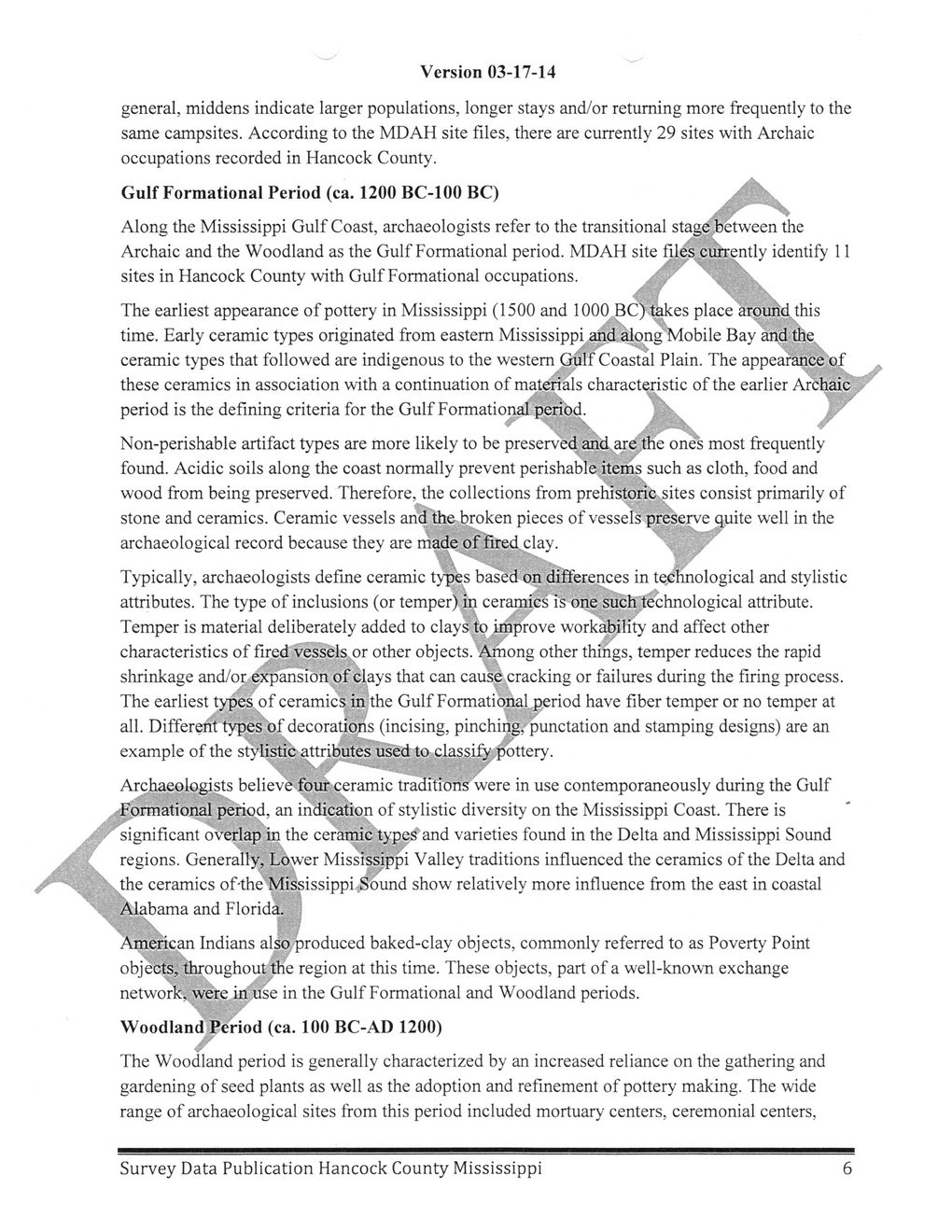This text was obtained via automated optical character recognition.
It has not been edited and may therefore contain several errors.
Version 03-17-14 general, middens indicate larger populations, longer stays and/or returning more frequently to the same campsites. According to the MDAH site files, there are currently 29 sites with Archaic occupations recorded in Hancock County. Gulf Formational Period (ca. 1200 BC-100 BC) Along the Mississippi Gulf Coast, archaeologists refer to the transitional stage .between the Archaic and the Woodland as the Gulf Formational period. MDAH site files currently identify 11 sites in Hancock County with Gulf Formational occupations. 'V \ The earliest appearance of pottery in Mississippi (1500 and 1000 BC) takes place arourid this time. Early ceramic types originated from eastern Mississippi and along Mobile Bay and the. ceramic types that followed are indigenous to the western Gulf Coastal Plain. The appearance of these ceramics in association with a continuation of materials characteristic of the earlier Archaic period is the defining criteria for the Gulf Formational period. \ ^ Non-perishable artifact types are more likely to be preserved and are the ones most frequently found. Acidic soils along the coast normally prevent perishable items such as cloth, food and wood from being preserved. Therefore, the collections from prehistoric sites consist primarily of stone and ceramics. Ceramic vessels and the broken pieces of vessels preserve quite well in the archaeological record because they are made of fired clay. Typically, archaeologists define ceramic types based on differences in technological and stylistic attributes. The type of inclusions (or temper) in ceramics is one such technological attribute. Temper is material deliberately added to clays to improve workability and affect other characteristics of fired vessels or other objects. Among other things, temper reduces the rapid shrinkage and/or expansion of clays that can cause cracking or failures during the firing process. The earliest types of ceramics in the Gulf Formational period have fiber temper or no temper at all. Different types of decorations (incising, pinching, punctation and stamping designs) are an example of the stylistic attributes used to classify pottery. Archaeologists believe four ceramic traditions were in use contemporaneously during the Gulf -Formational period, an indication of stylistic diversity on the Mississippi Coast. There is significant overlap in the ceramic types and varieties found in the Delta and Mississippi Sound regions. Generally, Lower Mississippi Valley traditions influenced the ceramics of the Delta and the ceramics of-the'Mississippi Sound show relatively more influence from the east in coastal Alabama and Florida, j American Indians also.produced baked-clay objects, commonly referred to as Poverty Point objects, throughout the region at this time. These objects, part of a well-known exchange \ / network, were in .use in the Gulf Formational and Woodland periods. Woodland Period (ca. 100 BC-AD 1200) y The Woodland period is generally characterized by an increased reliance on the gathering and gardening of seed plants as well as the adoption and refinement of pottery making. The wide range of archaeological sites from this period included mortuary centers, ceremonial centers, Survey Data Publication Hancock County Mississippi 6

Hancock County History and Archeology Survey-Publication-Data-2014-(08)